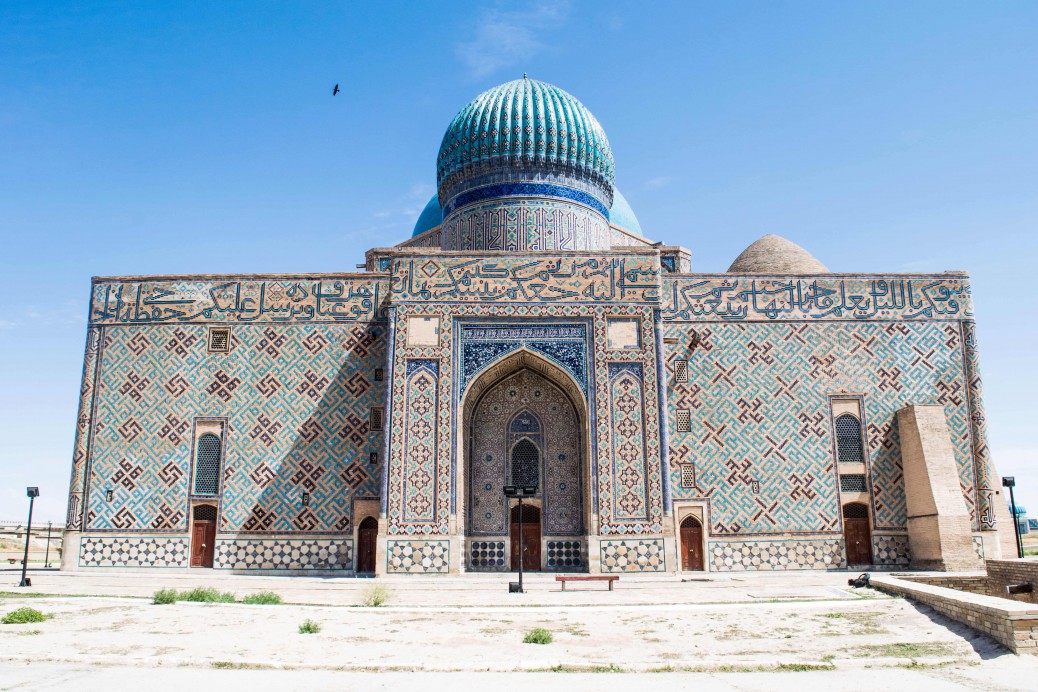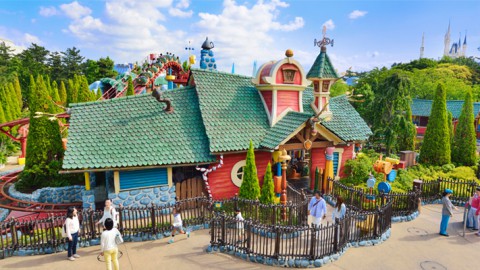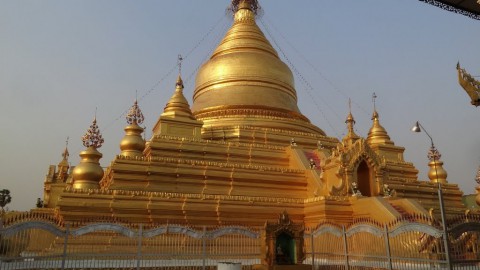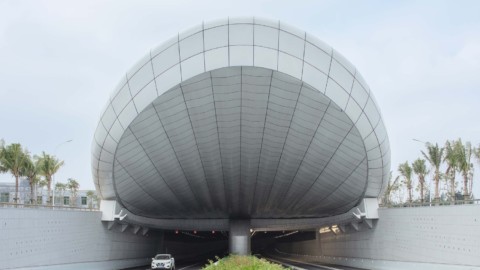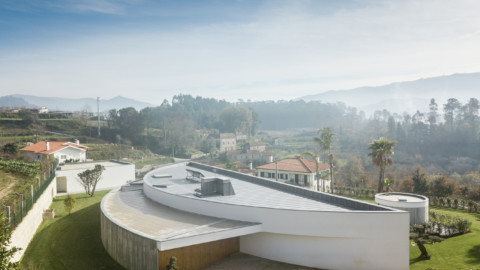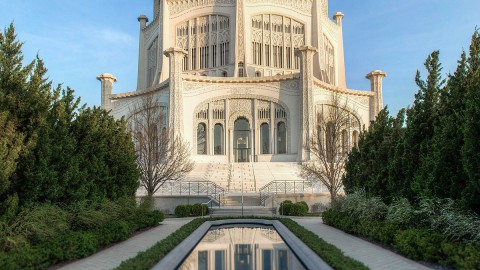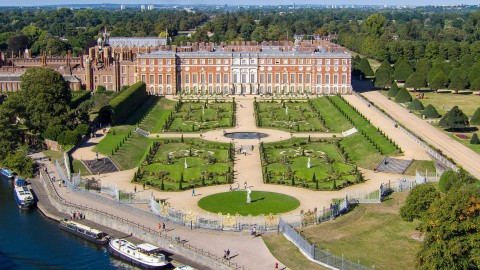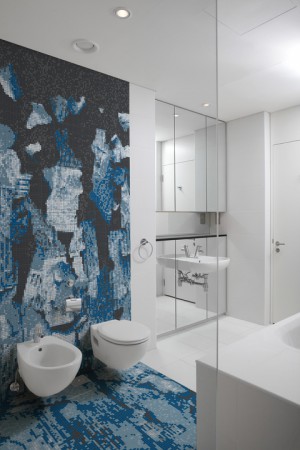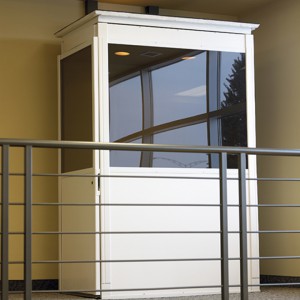Mausoleum of Khoja Ahmed Yasawi
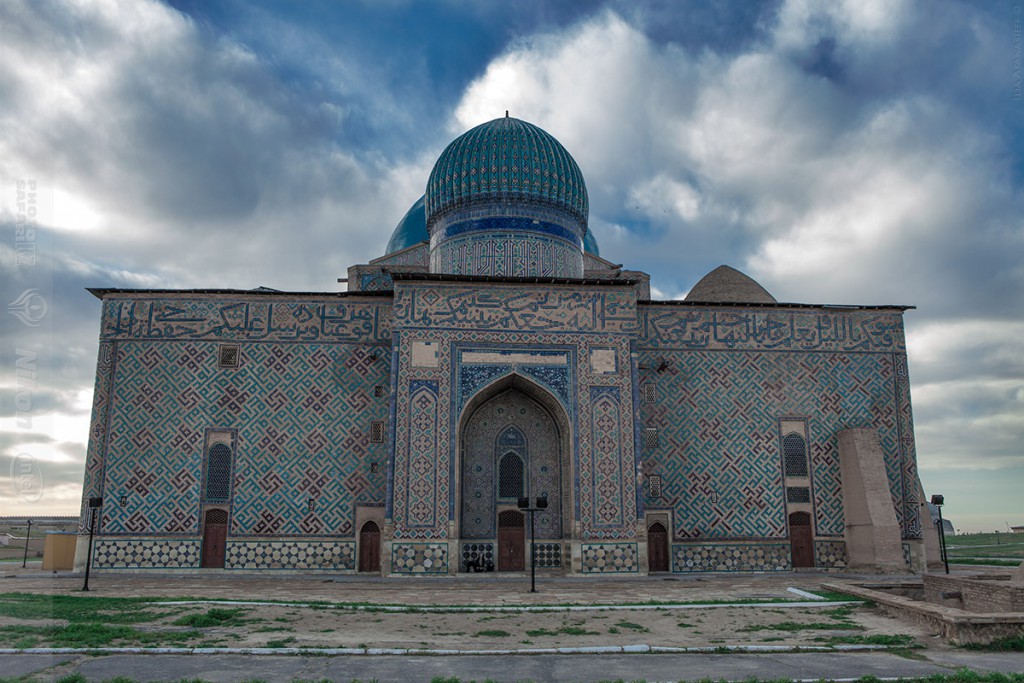
The Mausoleum of Khawaja Ahmed Yasawi (Kazakh: Қожа Ахмет Яссауи кесенесі, Qoja Ahmet Iassaýı kesenesi) is a mausoleum in the city of Turkestan, in southern Kazakhstan. The structure was commissioned in 1389 by Timur, who ruled the area as part of the expansive Timurid Empire, to replace a smaller 12th-century mausoleum of the famous Turkic poet and Sufi mystic, Khoja Ahmed Yasawi (1093–1166). However, construction was halted with the death of Timur in 1405.
Despite its incomplete state, the mausoleum has survived as one of the best-preserved of all Timurid constructions. Its creation marked the beginning of the Timurid architectural style.The experimental spatial arrangements, innovative architectural solutions for vault and dome constructions, and ornamentations using glazed tiles made the structure the prototype for this distinctive art, which spread across the empire and beyond.
The religious structure continues to draw pilgrims from across Central Asia and has come to epitomize the Kazakh national identity. It has been protected as a national monument, while UNESCO recognized it as the country’s first site of patrimony, declaring it a World Heritage Site in 2003.
Khawaja Ahmed Yasawi陵墓(哈薩克斯坦:QожаАхметЯссауикесенесі,QojaAhmetIassaýıkesenesi)是位於哈薩克斯坦南部土耳其斯坦市的一座陵墓。這座建築於1389年由帖木兒委任,後者將該地區統治為廣闊的帖木兒帝國的一部分,以取代著名的突厥詩人和蘇菲神秘主義者Khoja Ahmed Yasawi(1093-1166)的12世紀小型陵墓。然而,隨著帖木兒在1405年去世,建築工程停止了。
儘管狀態不完整,但陵墓仍然是所有帖木兒建築中保存最完好的建築之一。它的創造標誌著帖木兒建築風格的開始。實驗空間佈局,拱頂和圓頂建築的創新建築解決方案以及使用釉面磚的裝飾使該結構成為這種獨特藝術的原型,遍布帝國及其他地區。
宗教結構繼續吸引來自中亞各地的朝聖者,並成為哈薩克民族身份的縮影。它被保護為國家紀念碑,而聯合國教科文組織則認為它是該國第一個遺產遺址,並在2003年宣布它為世界遺產。
General information
Type:Mausoleum
Architectural style:Timurid, by Khawje hossein shirazi
Location:Turkistan, Kazakhstan
Coordinates:43°17′35″N 68°16′28″ECoordinates: 43°17′35″N 68°16′28″E
Construction started:14th century
Official name:Mausoleum of Khawaja Ahmed Yasawi
Type:Cultural
Designated:2003 (27th session)
State Party:Kazakhstan
Region:Asia-Pacific
一般信息
類型:陵
建築風格:帖木兒,由Khawje hossein shirazi設計
地點:哈薩克斯坦土耳其斯坦
坐標:43°17’35“N 68°16’28”ECoordinates:43°17’35“N 68°16’28”E
施工開始:14世紀
官方名稱:Khawaja Ahmed Yasawi陵墓
類型:文化
指定:2003年(第27屆)
締約國:哈薩克斯坦
地區:亞太
Location
The Mausoleum of Khawaja Ahmed Yasawi is situated in the north-eastern part of the modern-day town of Turkestan (formerly known as Hazrat-e Turkestan), an ancient centre of caravan trade known earlier as Khazret and later as Yasi, in the southern part of Kazakhstan. The structure is within the vicinity of a historic citadel, which is now an archaeological site.
Remains of medieval structures such as other mausoleums, mosques and bath houses characterize the archaeological area. To the north of the Mausoleum of Khawaja Ahmed Yasawi, a reconstructed section of the citadel wall from the 1970s separates the historical area from the developments of the modern town.
地點
Khawaja Ahmed Yasawi陵墓位於現代城鎮土耳其斯坦(以前稱為Hazrat-e Turkestan)的東北部,這是一個古老的商隊貿易中心,早期稱為Khazret,後來稱為Yasi,位於南部 哈薩克斯坦的一部 該建築位於歷史悠久的城堡附近,現在是一個考古遺址。
中世紀建築的遺跡,如其他陵墓,清真寺和浴室,是考古區的特色。 在Khawaja Ahmed Yasawi陵墓的北面,20世紀70年代的城堡牆的重建部分將歷史區域與現代城鎮的發展區分開來。
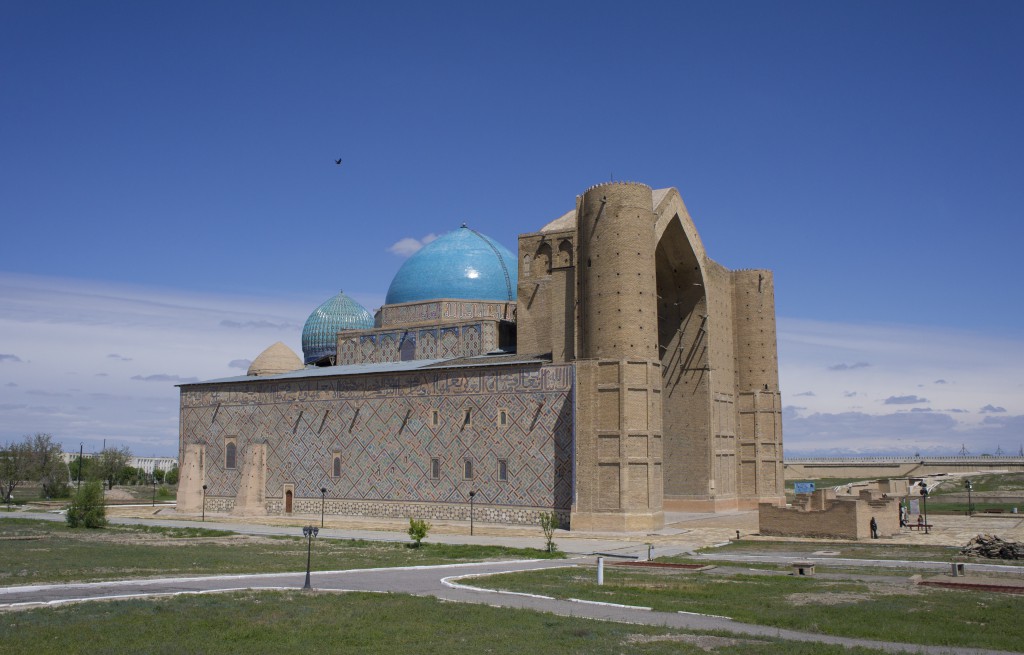
History
Khawaja Ahmed Yasawi
Khoja Ahmed Yasawi (Khawaja or Khwaja (Persian: خواجه pronounced khâje) corresponds to “master”, whence Arabic: خواجة khawājah), also spelled as Khawajah Akhmet Yassawi, was the 12th-century head of a regional school of Sufism, a mystic movement in Islam which began in the 9th century. He was born in Ispidjab (modern Sayram) in 1093, and spent most of his life in Yasi, dying there in 1166. He is widely revered in Central Asia and the Turkic-speaking world for popularizing Sufism, which sustained the diffusion of Islam in the area despite the contemporary onslaught of the Mongol invasion. The theological school he created turned Yasi into the most important medieval enlightening center of the area. He was also an outstanding poet, philosopher and statesman. Yasawi was interred in a small mausoleum, which became a pilgrimage site for Muslims.
歷史
Khawaja Ahmed Yasawi
Khoja Ahmed Yasawi(Khawaja或Khwaja(波斯語:خواجه發音為khâje)對應於“大師”,其中阿拉伯語:خواجةkhawājah),也稱為Khawajah Akhmet Yassawi,是12世紀蘇菲派地區學校的負責人,一個神秘的運動 伊斯蘭教始於9世紀。 他於1093年出生於Ispidjab(現代賽拉姆),並且大部分時間都生活在雅西,於1166年在那裡度過。他在中亞和突厥語世界廣受尊敬,以推廣蘇非派,這使得伊斯蘭教在 儘管蒙古入侵的當代猛攻,該地區仍然存在。 他創建的神學院將雅西變成了該地區最重要的中世紀啟蒙中心。 他也是一位傑出的詩人,哲學家和政治家。 Yasawi被埋葬在一個小陵墓中,成為穆斯林的朝聖地。
New mausoleum
The town of Yasi was largely spared during the Mongol invasion of Khwarezmia in the 13th century. Overtime, the descendants of the Mongols settled in the area and converted to Islam. The town then came under the control of the Timurid Dynasty in the 1360s. Timur (Tamerlane), the founder of the dynasty, expanded the empire’s realm to include Mesopotamia, Iran, and all of Transoxiana, with its capital located in Samarkand. To gain the support of local citizens, Timur adopted the policy of constructing monumental public and cult buildings. In Yasi, he put his attention to the construction of a larger mausoleum to house Yasawi’s remains,with the intention of glorifying Islam, promoting its further dissemination, and improving the governance of the immediate areas.
The new mausoleum was begun in 1389. Timur imported builders from cities which he laid waste during his campaigns, including mosaic-workers from Shiraz and stonemasons and stucco-workers from Isfahan. The master builders were led by Khwaja Hosein Shirazi from Iran. It was reported that Timur himself participated in the design of the structure, where he introduced experimental spatial arrangements, types of vaults and domes. These innovations were later implemented in the religious edifices of other cities. However, the mausoleum was left unfinished, when Timur died in 1405.
新的陵墓
在13世紀蒙古人入侵Khwarezmia期間,Yasi鎮基本上倖免於難。加班,蒙古人的後裔在該地區定居並皈依伊斯蘭教。然後,鎮在十六世紀六十年代受到帖木兒王朝的控制。該王朝的創始人帖木兒(帖木兒)擴大了帝國的領域,包括美索不達米亞,伊朗和所有Transoxiana,其首都位於撒馬爾罕。為了獲得當地公民的支持,帖木兒採取了建造具有紀念意義的公共和邪教建築的政策。在雅西,他把注意力集中在建造一座更大的陵墓上,以容納亞薩維的遺體,目的是美化伊斯蘭教,促進其進一步傳播,並改善近處的治理。
新的陵墓始於1389年。帖木兒從他在競選期間浪費的城市進口建築商,包括設拉子的馬賽克工人和來自伊斯法罕的石匠和灰泥工人。主建築商由來自伊朗的Khwaja Hosein Shirazi領導。據報導,帖木兒親自參與了該結構的設計,在那裡他介紹了實驗性空間佈局,拱頂和圓頂類型。這些創新後來在其他城市的宗教建築中實施。然而,當帖木兒於1405年去世時,陵墓未完成。
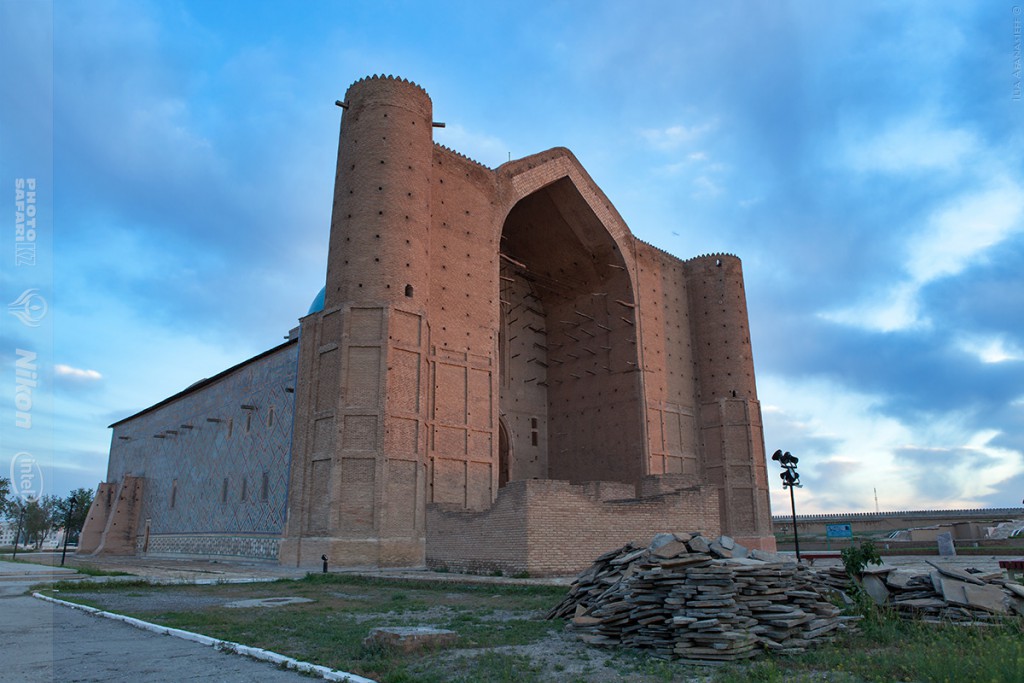
Decline and preservation
When the Timurid Empire disintegrated, control of the immediate territory passed on to the Kazakh Khanate, which made Yasi, then renamed Turkestan, its capital in the 16th century. The khans (Turkic for “ruler”) sought to strengthen the political and religious importance of Turkestan to unify the nomadic tribes within the young state. Hence, as the khanate’s political center, ceremonies for the elevation of the khans to the throne and missions from neighboring states were received in Turkestan. The Kazakh nobility also held their most important meetings to decide state-related matters in the capital.
The town, situated on the border of the nomadic and settled cultures, flourished as the khanate’s largest trade and craft center. Fortifications were erected to safeguard this commercial role, including the 19th-century construction of defensive walls around the unfinished mausoleum, which became an important landmark and pilgrimage center of the town. In the succeeding centuries, Turkestan and its historic monuments became connected with the idea of the Kazakh state system. Political struggles and the shift in overland trade in favor of maritime routes soon led to the town’s decline, before it finally passed on to the Russian Empire in 1864.
拒絕和保存
當帖木兒帝國解體時,對直接領土的控制權轉移到了哈薩克汗國,後者使雅西在16世紀重新命名為土耳其斯坦。可汗(突厥語稱為“統治者”)試圖加強土耳其斯坦的政治和宗教重要性,以統一年輕國家內的游牧部落。因此,作為汗國的政治中心,土耳其斯坦接受了將可汗升格為王位和來自鄰國的任務的儀式。哈薩克斯坦貴族還舉行了最重要的會議,以決定首都的國家事務。
該鎮位於游牧民族和定居文化的邊界,是汗國最大的貿易和工藝中心。為了保護這一商業角色,建立了防禦工事,包括19世紀在未完工的陵墓周圍建造防禦牆,後者成為該鎮的重要地標和朝聖中心。在接下來的幾個世紀裡,土耳其斯坦及其歷史古蹟與哈薩克斯坦國家體系的思想聯繫在一起。在1864年最終傳承到俄羅斯帝國之前,政治鬥爭以及有利於海上航線的陸上貿易的轉變很快導致該鎮的衰落。
The town was eventually deserted; a new town center was developed west of the area, built around a new railway station. The territory came under Soviet rule by the 20th century. The new administration carried out preservation and restoration work on site, although they considered it more as an architectural rather than a spiritual structure. Hence, the mausoleum was closed to the devotees who came to pay homage to Yasawi. Nevertheless, the local khoja based at the mausoleum allowed pilgrims to secretly enter the structure at night.Beginning in 1922, several commissions took part in the technical investigation of the building. Regular maintenance has been in place beginning in 1938, while a series of restoration campaigns were started in 1945, with the last one being held from 1993 to 2000.Among the latest conservation steps implemented were the replacement of the structure’s clay foundation with reinforced concrete, the consolidation of walls, the waterproofing of the roofs, and the layering of new tiles, based on historic designs and patterns, on the domes. The continuous conservation works have been in place when Kazakhstan gained its independence. The building is protected as a national monument and is included on the List of National Properties of Kazakhstan. The site is under the administration of the Azret-Sultan State Historical and Cultural Reserve Museum, in charge with the safeguarding, research, conservation, monitoring and maintenance of the mausoleum.
這個小鎮最終被遺棄了;在該地區以西開發了一個新的城鎮中心,圍繞一個新的火車站建造。該領土在20世紀受蘇聯統治。新政府在現場進行了保護和修復工作,儘管他們認為這更像是建築而非精神結構。因此,陵墓對前來向Yasawi致敬的奉獻者是封閉的。然而,位於陵墓的當地khoja允許朝聖者在夜間秘密進入該建築物。從1922年開始,幾個委員會參與了該建築的技術調查。從1938年開始定期維護,1945年開始進行一系列恢復活動,最後一次從1993年到2000年開始。在最近實施的保護措施中,用鋼筋混凝土代替結構的粘土基礎,基於歷史設計和圖案,在圓頂上鞏固牆壁,屋頂防水,以及新瓷磚的分層。哈薩克斯坦獲得獨立後,已經開展了持續的保護工作。該建築作為國家紀念碑受到保護,並被列入哈薩克斯坦國家財產清單。該遺址由Azret-Sultan國家歷史和文化保護區博物館管理,負責陵墓的保護,研究,保護,監測和維護。
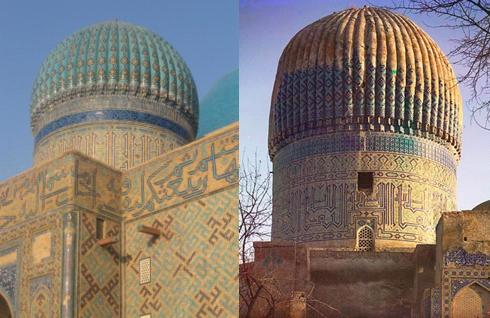
Architecture
The unfinished state of the Mausoleum of Khawaja Ahmed Yasawi, especially at the entrance portal and sections of the interior, allow for the better architectural scrutiny of how the monument was designed and constructed. The structure is rectangular in plan, measuring 45.8 × 62.7 m (150.3 × 205.7 ft), and is 38.7 m (127.0 ft) high. It is oriented from the south-east to the north-west.
The primary material used for the building is ganch—fired brick mixed with mortar, gypsum and clay—which was made in a plant located in Sauran. Layers of clay reaching a depth of 1.5 m (4.9 ft), to prevent the water penetration, were used for the original foundation.These were replaced with reinforced concrete in modern restoration works. The main entrance to the mausoleum is from the south-east, through which visitors are ushered into the 18.2 × 18.2-m (59.7 × 59.7-ft) Main Hall, known as Kazandyk (the “copper room”). The section is covered by the largest existing brick dome in Central Asia, also measuring 18.2 m (59.7 ft) in diameter. At the center of the Kazandyk is a bronze cauldron, used for religious purposes. The tomb of Yasawi is situated on the central axis at the end of the building in the northwest, with the sarcophagus located exactly at the center of the section, which has a double dome ribbed roof —the inner dome being 17.0 m (55.8 ft) high and the outer dome being 28.0 m (91.9 ft) high. The dome exterior is covered with hexagonal green glazed tiles with gold patterns. The interior is adorned with alabaster stalactites, known as muqarnas. Additional rooms in the structure, totaling more than 35, include meeting rooms, a refectory, a library, and a mosque, which had light blue geometric and floral ornaments on its walls. The mausoleum’s exterior walls are covered in glazed tiles constituting geometric patterns with Kufic and Suls epigraphic ornaments derived from the Qur’an. Initial plans also called for the addition of two minarets, but this was not realized when construction was halted in 1405.
建築
Khawaja Ahmed Yasawi陵墓的未完工狀態,特別是在入口門戶和內部部分,可以對建築物的設計和建造進行更好的建築審查。該結構為平面矩形,尺寸為45.8×62.7米(150.3×205.7英尺),高度為38.7米(127.0英尺)。它從東南到西北。
用於建築物的主要材料是與砂漿,石膏和粘土混合的ganch燒製磚 – 這是在位於Sauran的工廠生產的。為了防止水滲透,粘土層深達1.5米(4.9英尺),用於原始基礎。在現代修復工程中,這些粘土被鋼筋混凝土取代。陵墓的主要入口來自東南部,遊客通過該入口進入18.2×18.2米(59.7×59.7英尺)的大廳,即Kazandyk(“銅房”)。該區域由中亞現有最大的磚穹頂覆蓋,直徑18.2米(59.7英尺)。在Kazandyk的中心是一個青銅坩堝,用於宗教目的。 Yasawi墓位於西北部建築物盡頭的中軸線上,石棺正好位於剖面中央,有一個雙圓頂羅紋屋頂 – 內圓頂為17.0米(55.8英尺)高,外圓頂高28.0米(91.9英尺)。圓頂外部覆蓋有六角形綠色釉面磚,金色圖案。內部裝飾著雪花石膏鐘乳石,稱為muqarnas。該建築的其他房間總數超過35間,包括會議室,食堂,圖書館和清真寺,牆壁上有淺藍色的幾何和花卉裝飾。陵墓的外牆覆蓋著釉面磚,構成了幾何圖案,其中古法和蘇爾的書法飾品來自古蘭經。初步計劃還要求增加兩個尖塔,但在1405年建築停工時沒有實現這一點。
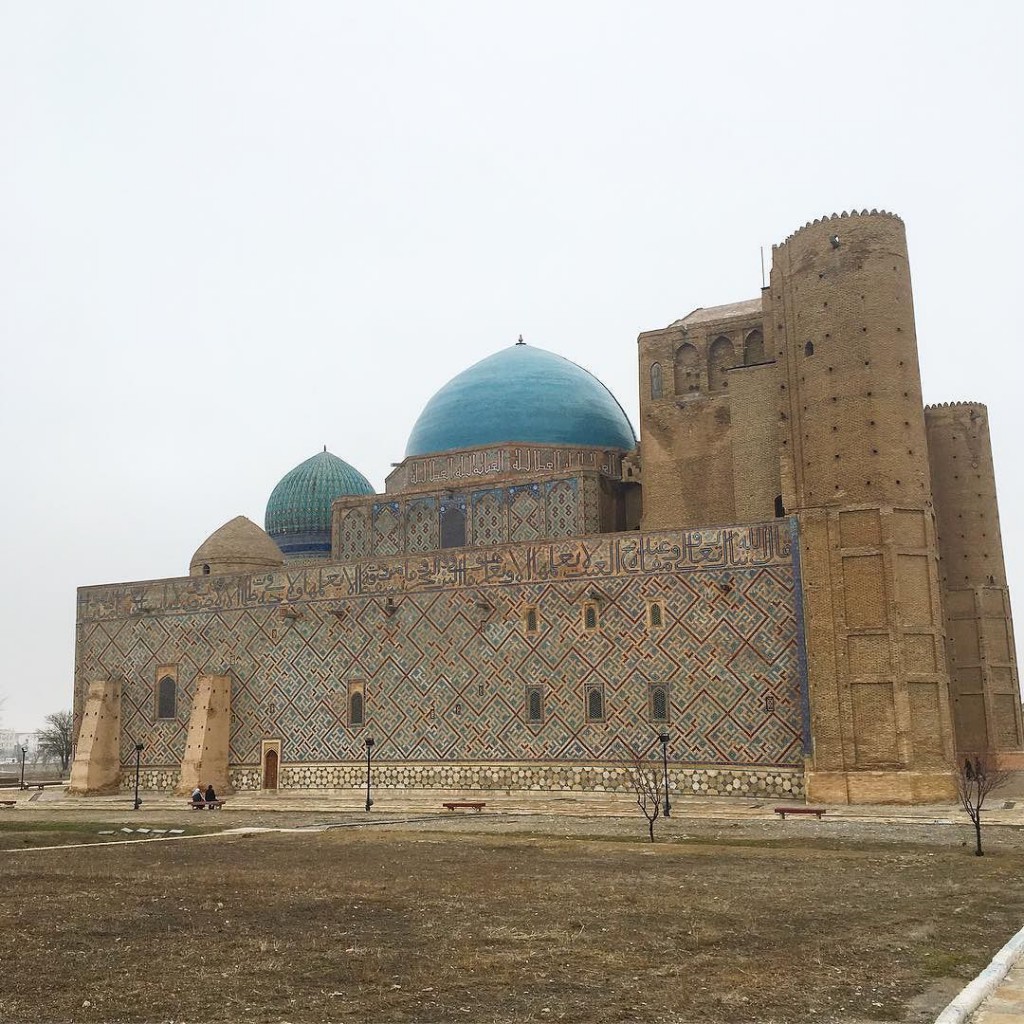

FROM:https://en.wikipedia.org/wiki/Mausoleum_of_Khoja_Ahmed_Yasawi
FROM:Mausoleum of Khoja Ahmed Yasawi in Turkestan · Kazakhstan
FROM:Khoja Ahmed Yasawi Mausoleum
Don’t you think it’s addictive?
Want to know more about the beauty of architecture?
Come and join our members to explore the beauty of architectural design.
覺得看得不過癮嗎?
想要知道更多建築之美嗎?
快來加入我們的會員,一同探索建築設計之美。
The above article is purely for appreciation and sharing purposes, as well as the construction of new technology and the public can be in-depth understanding of the information at the same time there are sources, will be able to query, no use of the document as a commercial transaction, if illegal, please inform the We will immediately remove the site, thank you for cooperation.
以上文章純粹作為欣賞及分享用途,以及將建築新型技術傳遞給與大眾能夠深入了解,同時資料還有來源,將可查詢,絕無使用該文件資料作為商業交易行為,如有違法請務必告知該網站我們將立即處理撤除,謝謝合作。

